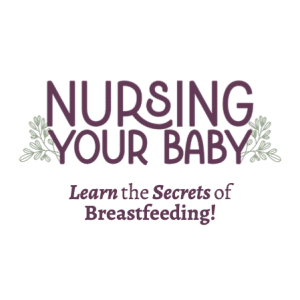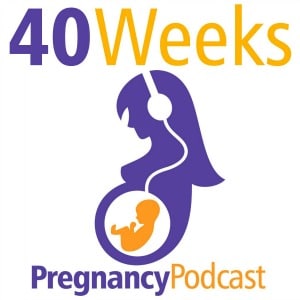For many expecting moms, weeks 13 to 27 are often considered the most enjoyable part of pregnancy. In this episode, learn everything you need to know to navigate the second trimester confidently. Your belly will start to show, you may begin to feel your baby kicking, and many first-trimester symptoms, like morning sickness, begin to fade. You have likely settled into healthy routines, and with more stable moods and increased energy, you may feel more like yourself again. After the internal changes of the first trimester, the second brings noticeable physical changes. We will cover what to expect at your second-trimester prenatal appointments, key to-do items to focus on, and ways your partner can support you during this stage.
Listen Now
This episode is made possible with support from our sponsors. I appreciate your support for the brands that help power this podcast.

20% off the Practical Guide to Nursing Your Baby Course with code PREGNANCYPODCAST. Everything you need to know about breastfeeding with lifetime access to over 4 hours of video lessons, a growing bonus content library, helpful PDFs, and over 60 real-world pro tips.

The VTech V-Hush Pro Baby Sleep Soother helps you create ideal sleep patterns and environments for your baby, so your whole family gets better and longer sleep. Available at Walmart and Amazon.

Take the FREE “Is Your Dog Ready for Baby?” Quiz and get your personalized Baby Prep Toolkit, with clear, proven strategies to help your dog feel safe, understood, and ready for this transition.

Try AG1 and get a FREE 1-year supply of immune-supporting Vitamin D AND 5 FREE AG1 travel packs with your first purchase.
Become a Pregnancy Podcast Premium member or log in to access all articles and episodes ad-free.
Article and Resources
Weeks 13 to 27
The second trimester of your pregnancy goes from week 13 to 27. Generally, the second trimester is the most liked. Morning sickness should dissipate, you should feel like you have more energy, and your baby bump makes an appearance. This is the trimester to enjoy your pregnancy and get excited about your baby.

For a week-by-week update throughout your pregnancy, listen to the 40 Weeks podcast. Each episode focuses on a specific week, highlighting your baby’s development, changes in your body, what to expect at prenatal appointments, and a helpful tip for dads and partners.
Your Growing Baby
Your baby is growing so much this trimester. Their skeleton and bones are developing. Fat stores begin to develop under your baby’s skin, and this will provide energy and help keep your baby warm after birth. A fine, down-like hair called lanugo completely covers their body. Lanugo helps hold the vernix caseosa. This greasy and cheese-like coating protects their delicate skin from abrasions and hardening from exposure to the amniotic fluid. They also have hair on their head and eyebrows. Your baby’s lungs and nervous system continue to mature, and fingerprints and footprints are forming.
As your baby becomes more active, their movements become more coordinated. Your baby is regularly sleeping and waking. They have rapid eye movements, make sucking motions with their mouth, and can swallow. Around week 20, you will likely start to feel your baby kick and move. You may notice these movements even earlier if this is not your first pregnancy. Feeling your baby move is an exciting milestone, and it can be just as special for your partner. When your baby is active, invite your partner to place a hand on your belly so they can feel those little kicks, too.
Common Second Trimester Symptoms
Many symptoms can pop up in the second trimester. Some of these are a continuation of symptoms you experienced in the first twelve weeks, and others may be new challenges.
Physical Changes in the Second Trimester
In the first trimester, most of the changes are internal, and your body physically catches up in the second. Gaining weight is one of the more noticeable physical changes. After only gaining a few pounds in the first trimester, you should experience a steady, gradual weight gain throughout the remainder of your pregnancy. Women vary all over the spectrum on how they feel about their body image during pregnancy. Some mothers feel unattractive, while others love their new curves and growing belly. No matter how you feel, it is on the spectrum of normal.
Breast Changes
Your breasts go through many changes during pregnancy. If you experienced tenderness in the first trimester, that may begin to ease. However, you can still expect them to continue growing. As your body prepares to produce milk, additional fat accumulates in your breasts, so you may need to go up a bra size. It is a good idea to hold off on buying too many new bras early on, since your size may continue to increase. See this article for an in-depth explanation of the changes you can expect with your breasts during pregnancy.
Skin Changes
For many expecting moms, pregnancy can cause some challenging skin issues. The good news is that most of these skin issues are temporary and will disappear after your baby is born. See this episode for a breakdown of symptoms, causes, prevention, and treatment of skin issues.
Stretch marks are probably one of the most disliked side effects of pregnancy. These off-color lines may appear towards the end of this trimester on your breasts, belly, butt, and thighs. These lines can be pink or reddish and fade to a lighter color than your skin tone. The good news is that stretch marks fade over time. Stretch marks happen when the underlying supporting tissue stretches and tears during rapid stretching of your skin. Affected skin may feel tight and itchy. Genetics plays the most significant part in your susceptibility to stretch marks, which, unfortunately, you cannot control.
This study evaluated many topical treatments, and there was no clear evidence that any of them effectively prevented stretch marks. There is some interesting research on Centella asiatica. The best centella asiatica product I’ve found for stretch marks is the True Belly Serum by 8 Sheep Organics. Save 10% with the code PREGNANCYPODCAST. All 8 Sheep’s products come with a 100% Happiness Guarantee; you can try them completely risk-free for 3 months.
You may notice changes to the pigmentation in your skin. A stripe down the center of your belly called a linea nigra may appear in the second trimester and get darker as your pregnancy progresses. This is common, and it will fade after you have your baby. An increase in melanin production causes some expecting mothers to get melasma. Melasma creates dark patches of skin on the forehead, cheeks, nose, or upper lip. Sun exposure can make this more noticeable, so wear a hat or sunscreen to minimize the sun on your face.
Bleeding Gums
Increased blood circulation can make your gums softer and cause them to bleed when you brush or floss your teeth. You can switch to a softer toothbrush and see if that helps. Please maintain your dental hygiene during pregnancy and take good care of your teeth and gums while expecting.
Increased Vaginal Discharge
Increased vaginal discharge is common during pregnancy. It is typically white and acidic, which may help prevent yeast and bacterial growth. If the discharge is bothersome, using a thin panty liner can help you stay comfortable. Be sure to check in with your care provider if the discharge is green or yellow, has a strong odor, or if you experience pain, soreness, or itching; these could be signs of a vaginal infection.
Potential Complications in the Second Trimester
A few complications may arise during the second half of your pregnancy. As always, please contact your doctor or midwife with any concerning symptoms.
Hypertensive Disorders
While some changes in blood pressure are normal during pregnancy, hypertensive disorders affect as many as 10% of all pregnancies worldwide. They are responsible for approximately 10% of all maternal deaths in the United States. This includes chronic hypertension, gestational hypertension, preeclampsia, HELLP (hemolysis, elevated liver enzymes, and low platelet count), and eclampsia. High blood pressure during pregnancy can pose serious risks for you and your baby, which is why your care provider closely monitors it.
If you are diagnosed with any gestational hypertension, you can expect additional monitoring throughout your pregnancy. You may have prenatal appointments more often, and your care provider may ask you to monitor your blood pressure at home and do a daily kick count. Your doctor may recommend additional ultrasounds to monitor your baby’s growth or other tests like a biophysical profile or non-stress test later in the third trimester.
ICP (Intrahepatic Cholestasis of Pregnancy)
Intrahepatic cholestasis of pregnancy is a liver condition that occurs when the flow of bile slows or stops, causing bile acids to build up in the bloodstream. This can lead to persistent itching, often on the palms of the hands or soles of the feet, and sometimes on the belly. The itching typically occurs without a rash and usually develops late in the second or early third trimester, resolving after birth. While the condition does not pose serious risks to the mother beyond discomfort, it is associated with an increased risk of complications for the baby.
PUPPP (Pruritic Urticarial Papules and Plaques of Pregnancy)
PUPPP stands for pruritic urticarial papules and plaques of pregnancy, or PEP in the UK (polymorphic eruption of pregnancy). This itchy rash is the most common skin condition during pregnancy. It usually appears late in the second or early in the third trimester. Studies show the incidence is 0.5% in single pregnancies and increases with twins and multiples. Thankfully, PUPPP does disappear after birth. If the symptoms are bothersome during pregnancy, some remedies exist to treat them.
PUPPP usually first appears in stretch marks on your belly. On your stomach, it surrounds your navel and can spread to your arms, thighs, butt, and other parts of your body. Although this can be uncomfortable, it does not increase the risk of adverse outcomes for you or your baby. See this episode for more information on the treatment of PUPPP.
Second Trimester Prenatal Appointments
During the second trimester, you continue seeing your doctor or midwife every four weeks. Never hesitate to ask questions. There is no such thing as a stupid question, especially when it comes to your pregnancy. Check out this article for five tips to make the most of every prenatal appointment.
Anatomy Scan
It is routine to have an ultrasound anatomy scan during the second trimester, typically between 18 and 20 weeks. This ultrasound checks for fetal malformations and structural abnormalities, confirms if you are carrying multiples, verifies your due date and your baby’s growth, assesses amniotic fluid levels, and evaluates your baby’s overall well-being. During the appointment, the ultrasound technician will take many measurements of your baby. As part of the anatomy scan, the ultrasound technician will examine the heart’s four chambers, kidneys, bladder, stomach, brain, spine, and sex organs. While I recommend your partner attend as many prenatal appointments as possible, this is a particularly fun appointment to see your baby and find out the sex. For more details on ultrasounds, check out this episode.
Prenatal Tests
Your doctor or midwife will offer or suggest several prenatal tests during your pregnancy, many of which are in the second trimester. You may feel like you are continually waiting for the result of some test to come back, for assurance that your baby is healthy. Most tests are routine, and the highest probability is that your baby is healthy.
When evaluating your testing options, there are a few things to remember. A screening test gives you the likelihood of a condition and may signal that additional testing is needed. You only know something for sure once you have a diagnostic test. All tests vary in their accuracy. Please discuss your testing options, results, or questions with your doctor or midwife.
Quad Screen
The quad screen is a maternal blood screening test examining proteins or hormones that can indicate your baby’s risk of trisomy 21, trisomy 18, spina bifida, and abdominal wall defects. The optimal time frame for this test is between 16 and 18 weeks, but the window is between 15 and 22 weeks. The quad screen test is slightly less accurate than the first-trimester screen.
Integrated Screening
An integrated screening test combines results from a quad screen test in the second trimester with the first-trimester screen. Combining results from both tests has a higher detection rate for Down syndrome than either of the two tests alone.
Amniocentesis
The primary reason for amniocentesis is to detect chromosome abnormalities, neural tube defects, and genetic disorders. The test is usually done between 15 and 20 weeks. A needle is inserted through your belly into the amniotic sac to collect a sample of fluid to be sent to a lab for analysis. An amniocentesis has a high level of accuracy of greater than 99%. This is an invasive diagnostic test that poses potential risks. A systematic review and meta-analysis found the miscarriage rate to be 0.11%. Side effects include cramping, leaking fluid, and minor irritation around the puncture site.
It is also possible that your care provider may recommend an amniocentesis later in the third trimester to assess uterine infections, determine the severity of fetal anemia in babies with Rh disease, or evaluate lung maturity before birth.
Gestational Diabetes Testing
Gestational diabetes is a type of diabetes that occurs during pregnancy and affects around 8% of pregnancies. The glucose challenge screening is a preliminary test to evaluate how your body processes sugar. Insulin resistance often starts around week 20, and you take this screening test between 24-28 weeks or sooner if you are at high risk. The glucose challenge screening test requires a blood sample. Then you drink a sweet glucose liquid (50g) within five minutes, and give another blood sample one hour later.
If you have a high level of glucose on the screening test, you will go on to take the glucose tolerance test, to rule out or diagnose the condition. Before taking the glucose tolerance test, your doctor will ask you to eat at least 150mg of carbohydrates for three days. 150 mg of carbs is what you will get from a slice or two of bread. You should not eat or drink anything but sips of water for 14 hours before the test. For this reason, it is best to schedule the test early in the morning. A technician will draw blood to measure your baseline fasting blood glucose level. You drink a glucose solution (75g or 100g). Then your blood will be drawn and tested every hour for the next three hours.
This episode breaks down gestational diabetes, testing, treatment, risks, and how this affects your pregnancy, birth, and baby.
RhoGAM
In addition to your blood type, you have a positive or negative Rh factor. If you are Rh-negative and your baby is Rh-positive, then you have an Rh incompatibility. If your Rh-negative blood is exposed to your baby’s Rh-positive blood, your blood reacts by producing antibodies that can attack and destroy your baby’s Rh-positive blood cells. Usually, this does not happen. An injury, such as a car accident, can cause your blood and your baby’s blood to mix. This can also occur in situations, such as a miscarriage, an external cephalic version (a procedure to turn a breech baby), an invasive test like amniocentesis or CVS, or during birth if interventions like forceps, vacuum assistance, or a cesarean section are used.
To avoid the complications associated with an incompatibility, rho(D) immune globulin, commonly referred to by the brand name RhoGAM, is given as a shot at 26-28 weeks. You could have additional doses if an event caused the potential for blood mixing or after your baby is born. If your baby’s father is also Rh-negative, you may be able to avoid RhoGAM entirely. To learn about the risks, benefits, and considerations surrounding Rh compatibility with your baby and the RhoGAM shot, check out this episode.
Vaccines
Vaccines are a very controversial and complex topic. The choice to get vaccinated is a decision you should make with your doctor or midwife. If you have questions or concerns about any vaccine, please bring them up with your care provider. Vaccines should be given with informed consent. This means you are aware of all the risks and benefits, and you can opt in or opt out.
There are multiple vaccines that the American College of Obstetricians and Gynecologists recommends during pregnancy. Vaccines during pregnancy protect you and allow you to pass antibodies to your baby before they are born. Two vaccines (COVID-19 and influenza) are available in any trimester. If you declined the flu or COVID-19 vaccine in the first trimester, your doctor or midwife will likely offer or suggest these vaccines in the second trimester.
In the case of COVID-19 and influenza, you have options on timing and multiple options for the vaccine you get. These resources have more in-depth information on these vaccines and your options:
- COVID-19 Vaccine in Pregnancy: Risks, Benefits, and Research
- Flu Vaccine in Pregnancy: Evidence-Based Risks and Benefits
To-Do Items for the Second Trimester
The second trimester is the perfect time to take advantage of feeling like you have more energy and get things done. It can be overwhelming to think about everything you need to do to prepare for birth and having a newborn. By knocking out some big items in the second trimester, you can set yourself up to relax and be more prepared for the final months before your baby arrives.
Get Maternity Clothes
As your baby grows and your uterus expands, you will likely start to show early in the second trimester. Eventually, your favorite jeans may no longer fit. While there are hacks to make your regular clothes work a bit longer, you will feel much more comfortable in maternity clothes. You do not need to spend a fortune on a new wardrobe. Second-hand shops or hand-me-downs from friends can be great options. Please do not suffer in uncomfortable clothes. Adding a few maternity basics to your wardrobe is worth it.
Travel
This trimester often brings relief from many of the uncomfortable symptoms of early pregnancy, making it an ideal time to plan a vacation or a babymoon. In the third trimester, energy levels tend to dip again, and your growing belly can make travel more uncomfortable. As your due date approaches, you may feel less comfortable being far from home, your care provider, or your planned birth location. The timeframe of your travel is sometimes out of your control. If you have the flexibility to choose, the second trimester is usually the best time to go. Whether taking a road trip, hopping on a train, or flying abroad, this episode offers tips to help you stay healthy and comfortable while traveling during pregnancy.
Education and Preparation in the Second Trimester
The second trimester is a great time to learn more about pregnancy, birth, and life with a newborn. With the early symptoms easing and your energy returning, you may feel more focused and ready to dive into education and planning. If you leave all of this for the next trimester, you may feel overwhelmed and stressed before your due date. Use this time to explore your birth options and start thinking about the experience you want. It is also a good idea to begin preparing for breastfeeding by learning how it works, what challenges may come up, and where to get support. As you start picturing life with your baby, you can begin thinking about your parenting values and how you and your partner want to approach things like sleep, routines, and bonding.
Manage Stress
Pregnancy can be a time of additional stress as you are experiencing many physical changes and preparing for birth and a new baby. Everything you expose yourself to during pregnancy can also affect your baby, and stress is no exception. Stress during pregnancy can affect your baby in many ways. Physiological changes and stress that increase your risk for complications can affect the health and development of your baby. How you and your baby are affected by stress is a function of your stress response and ability to turn it off. The good news is that understanding your stress response and learning about evidence-based tools to manage stress will minimize the adverse effects on you and your baby and positively impact your mental health.
Plan for Maternity and Paternity Leave and Childcare
The second trimester is great for exploring your maternity and paternity leave options. You and your partner must determine how much time you can take off and whether you will be paid during leave. If you are employed, you can start by checking with your employer. Next, look into the policies in your state if you are in the United States. If you are in another country, check with government agencies.
If you or your partner is self-employed, consider putting systems in place to spend some time away from your business. At a minimum, cut down on hours. This is a short window of opportunity for you and your partner to be with your new baby. I urge both of you to explore your options and get creative to spend as much time as possible with your new baby. This episode covers navigating job protections, coordinating federal, state, and employer benefits, assessing your financial capacity for time off, and planning for a smooth transition back to work.
In addition to planning for maternity and paternity leave, you must plan for who will care for your baby if you return to work. This is an easy decision for some parents, and you may have the resources to have one parent stay home or a grandparent available. For other families, you need to find someone outside your family to watch your baby, like a nanny or daycare. I encourage you to think outside the box and explore all your options to find the right solution for your family. This episode overviews all of your options for childcare, cost, tips, and questions to select the right provider or daycare. Plus, strategies and tools to reduce the cost of childcare.
Build Your Baby Registry
The second trimester is perfect for building your baby registry or shopping for needed items. You have likely passed the initial overwhelm of early pregnancy and now have the time and energy to focus on what you will need for your baby’s arrival. Creating a registry helps you stay organized, prioritize essentials, and give friends and family a way to support you. This episode discusses considerations when choosing where to register, the pros and cons of the top options, and tips for building your baby registry. If you are unsure exactly what you need for your baby, this episode breaks it down, complete with the Ultimate List of the must-haves, optional items, and what is unnecessary.
Your Partner’s Role in the Second Trimester
If you don’t have a romantic partner or a co-parent, I encourage you to lean on friends and family so you are not going through this phase of your life without support.
Please encourage your partner to attend your doctor or midwife appointments. This allows your partner to be included, have input in major medical decisions, ask questions, and hear everything firsthand. If any complications come up throughout prenatal care or you get some unfavorable test results back, those appointments can be challenging to go through alone. Having your partner by your side can be a fantastic source of support. One of the more significant appointments for your partner to attend this trimester is the anatomy scan ultrasound. During this visit you will see a picture of your baby, hear their heartbeat, and find out the sex.
Whether you and your partner want to know about ultrasound safety or what kind of diapers to buy, there is plenty of research to do. Ask your partner to help with some of the research and reading. Check the Pregnancy Podcast website and utilize the search function. Chances are the work has already been done, and you can listen to a short episode or read an article for evidence on any topic.
Make the Most of Your Second Trimester
This is the golden trimester for a reason, and I hope it is treating you well. By this point, you have adjusted to many lifestyle changes to have a healthy pregnancy. Your moods and emotions should be evened out. Overall, you should feel like you have more energy. Take advantage of feeling good and knock out some of your to-do items in preparation for your baby. I hope you enjoy your second trimester.
Thank you to the brands that help power this podcast.

20% off the Practical Guide to Nursing Your Baby Course with code PREGNANCYPODCAST
Breastfeeding doesn’t always come easily or naturally, and the right education can make a big difference. The Practical Guide to Nursing Your Baby Course, created by Abby Egan, a registered labor and delivery nurse, Certified Lactation Educator, and experienced mother, walks you through everything you need to know to get breastfeeding off to a great start. The course includes lifetime access to over 4 hours of video lessons, a growing bonus content library, helpful PDFs, and over 60 real-world pro tips to support you throughout your breastfeeding journey. For a limited time, Pregnancy Podcast listeners can save 20% by using the promo code PREGNANCYPODCAST at checkout at nursingyourbaby.com.

VTech V-Hush Pro Baby Sleep Soother
The VTech V-Hush Pro Baby Sleep Soother has every feature you could possibly want to transform any room into a sleep sanctuary. Create ideal sleep patterns and environments for your baby, so your whole family gets better and longer sleep. The V-Hush Pro has built-in sleep programs and sleep tips from WeeSleep experts, over 200 pre-programmed stories, classical music, lullabies, and natural sounds. You can even record and upload your own voice, songs, or stories using the subscription-free app. The VTech V-Hush Pro Baby Sleep Soother is available at Walmart and Amazon.

Take the FREE “Is Your Dog Ready for Baby?” Quiz
Jaime Caponetta is my go-to expert for navigating life with a dog and a baby. Do not be caught off guard by your dog’s behavior when you bring your baby home. Take the FREE “Is Your Dog Ready for Baby?” quiz and get your personalized Baby Prep Toolkit, with clear, proven strategies to help your dog feel safe, understood, and ready for this transition. True connection doesn’t come from obedience—it comes from understanding. Take your free quiz today to build a safe, calm, and connected home for your whole family.

Try AG1 and get a FREE 1-year supply of immune-supporting Vitamin D AND 5 FREE AG1 travel packs with your first purchase.
AG1 Next Gen is a clinically backed daily health drink that combines a multivitamin, probiotic, and blend of superfoods into one scoop. AG1 delivers optimal amounts of nutrients in forms that help your body thrive. Just one scoop contains essential vitamins and nutrients, supports gut health, helps you feel sharp and focused, and supports a healthy immune system. (As a friendly reminder, pregnant or nursing women should seek professional medical advice before taking this or any other dietary supplement.)
